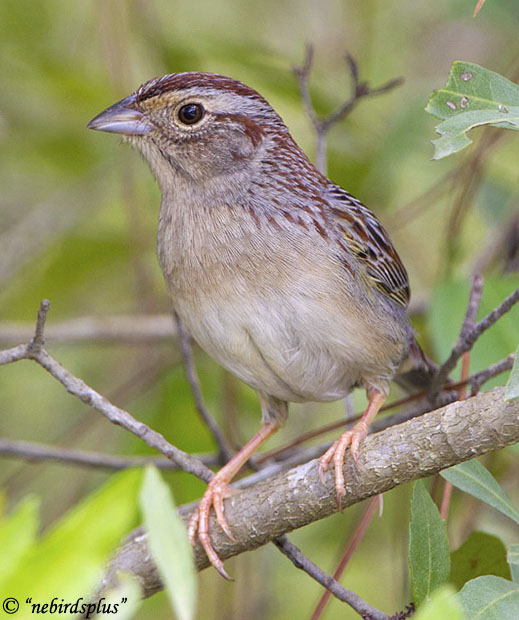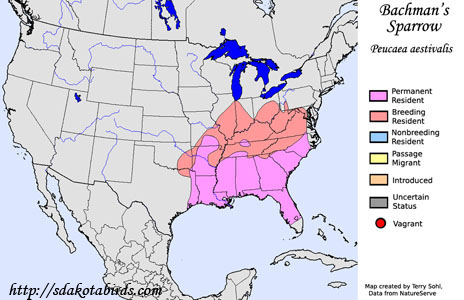| Length: 6 inches | Wingspan: 7.25 inches | Seasonality: Non-resident in South Dakota |
| ID Keys: Dark streaks on nape and back, gray face with strong rufous stripe behind eye, dark crown, whitish belly with buffy band on breast and flanks | ||
 The
Bachman's Sparrow is a specialty of the southeastern United States, with
birds found there at all seasons. Their preferred habitat are pine
forests with a relatively clear understory, a habitat that was once common
in the southeastern U.S., as natural fires usually kept the forest
undergrowth relatively low in mature pine forests. However, with human
management of forests in the southeastern U.S., fires have been greatly
suppressed, and pine forests themselves are often heavily managed for
timber. As a result, preferred habitat is greatly reduced in the
Southeast, and populations of Bachman's Sparrow have declined sharply in
recent decades. The species has learned to utilize other habitats,
however, such as recently clear-cut forests and powerline right-of-ways.
The
Bachman's Sparrow is a specialty of the southeastern United States, with
birds found there at all seasons. Their preferred habitat are pine
forests with a relatively clear understory, a habitat that was once common
in the southeastern U.S., as natural fires usually kept the forest
undergrowth relatively low in mature pine forests. However, with human
management of forests in the southeastern U.S., fires have been greatly
suppressed, and pine forests themselves are often heavily managed for
timber. As a result, preferred habitat is greatly reduced in the
Southeast, and populations of Bachman's Sparrow have declined sharply in
recent decades. The species has learned to utilize other habitats,
however, such as recently clear-cut forests and powerline right-of-ways.
Habitat: Found in pine forests with an open understory.
Diet: Feeds heavily on insects and spiders in the summer months. Seeds, especially grass seeds, are also consumed, and likely make up a large part of the diet in the winter months.
Behavior: Does nearly all of its foraging on the ground, hoping around and picking up food items from the ground.
Nesting: The nest of a Bachman's Sparrow is a cup of grasses and weeds, usually placed on the ground at the base of a shrub or similarly protected area. The female usually lays 3 or 4 eggs, with the female alone incubating them. Once the eggs hatch, both parents help to feed the nestlings, who usually leave the nest after about 10 days. Bachman's Sparrows may raise more than one brood in a breeding season.
Interactive eBird Map: Click to access an interactive eBird map of Bachman's Sparrow sightings
Song: The song of a Bachman's Sparrow is a whistle followed by a trill.
Migration: Birds in the southern part of their range are mostly permanent residents, while birds breeding in the northern part of their range move southward for the winter. Birds stay in the southeastern U.S. at all seasons though, with no longer-distance migration.
Similar Species: Most similar in appearance to Cassin's Sparrow and Botteri's Sparrow, but there is no overlap in range between those species. In range, perhaps most likely to be confused with Swamp Sparrow.
Conservation Status: Bachman's Sparrow populations have declined significantly in recent decades, probably due to loss of habitat. The IUCN currently lists the Bachman's Sparrow as "Near Threatened".
Further Information: 1) Audubon Guide - Bachman's Sparrow
2) Great Florida Birding Trail - Bachman's Sparrow
3) USGS Patuxent Bird InfoCenter- Bachman's Sparrow
Photo Information: Photo taken by "nebirdsplus" - March 29th, 2011 - Babcock Webb Wildlife Management Area near Fort Myers, Florida - Photo licensed under Creative Commons Attribution NonCommercial NoDerivs 2.0 Generic License
| Click below for a higher-resolution map |
 |
| South Dakota Status: Non-resident in South Dakota |
Additional Bachman's Sparrow Photos (coming soon!!)
